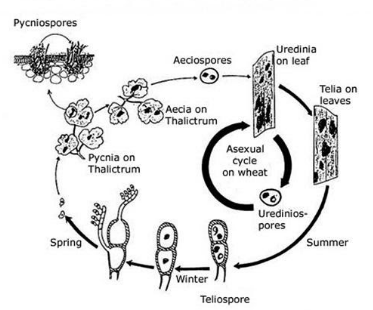
The sequence of spore production in Puccinia (wheat rust) is:
(A) Aeciospore, Uredospore, Teliospore, Basidiospore, Pycniospore
(B) Basidiospore, Aeciospore, Pycniospore, Teliospore
(C) Teliospore, Aeciospore, Uredospore, Basidiospore
(D) Teliospore, Basidiospore, Aeciospore, Pycniospore
Answer
452.7k+ views
Hint: Puccinia is a parasitic fungus that causes diseases in plants. The disease caused by these organisms is known as rust. The main crop which gets infected is the wheat plants
Complete answer:
The organism exists as an obligate parasite. It also requires two hosts throughout its lifecycle. The hosts are wheat and barberry plants. The plant produces fruiting bodies called spores and is the basic factor causing infection. The lifecycle of the parasite and thereby the disease cycle begins when the stems of the wheat plants are exposed to the parasite. The infected amount of parasites is known as the primary inoculum. The Burberry acts as a source of primary inoculum. The life cycle of Puccinia occurs through five stages.
The first stage is the transmission of the Aeciospores, these spores infect the wheat plants on germination.
The second stage involves the Uridinial stage, where uredospores are produced, which are single celled and thick-walled. It can be dispersed utilizing wind.
The third stage is the Telial stage, produced at the final stage of the growth of Uredospores. The spores produced at this point are known as tleto spores.
The fourth stage is the Basidial stage, which starts upon the germination of the previously produced spores. At this stage the fusion of the nuclei occurs, producing a diploid cell. And afterward, the four haploid nuclei are produced from it through meiosis.
The fifth and final stage is the pycnidial stage, where the mycelium produced from the basidiospores are germinated.

Figure: The life cycle of Puccinia showing the different stages of development of spores.
Thus the most appropriate option showing the correct sequence is A. The sequence of spore production in Puccinia is Aeciospore, Uredospore, Teliospore, Basidiospore, Pycniospore.
Note:
The plants other than wheat infected by the fungi are cereals such as Rye and Oats. And due to the requirement of two hosts for completion of the life cycle, it is known as a heteroecious host. The first three stages present in the wheat plant and affect the barberry plant while the last two stages produce in the barberry plant but affect the wheat plant.
Complete answer:
The organism exists as an obligate parasite. It also requires two hosts throughout its lifecycle. The hosts are wheat and barberry plants. The plant produces fruiting bodies called spores and is the basic factor causing infection. The lifecycle of the parasite and thereby the disease cycle begins when the stems of the wheat plants are exposed to the parasite. The infected amount of parasites is known as the primary inoculum. The Burberry acts as a source of primary inoculum. The life cycle of Puccinia occurs through five stages.
The first stage is the transmission of the Aeciospores, these spores infect the wheat plants on germination.
The second stage involves the Uridinial stage, where uredospores are produced, which are single celled and thick-walled. It can be dispersed utilizing wind.
The third stage is the Telial stage, produced at the final stage of the growth of Uredospores. The spores produced at this point are known as tleto spores.
The fourth stage is the Basidial stage, which starts upon the germination of the previously produced spores. At this stage the fusion of the nuclei occurs, producing a diploid cell. And afterward, the four haploid nuclei are produced from it through meiosis.
The fifth and final stage is the pycnidial stage, where the mycelium produced from the basidiospores are germinated.

Figure: The life cycle of Puccinia showing the different stages of development of spores.
Thus the most appropriate option showing the correct sequence is A. The sequence of spore production in Puccinia is Aeciospore, Uredospore, Teliospore, Basidiospore, Pycniospore.
Note:
The plants other than wheat infected by the fungi are cereals such as Rye and Oats. And due to the requirement of two hosts for completion of the life cycle, it is known as a heteroecious host. The first three stages present in the wheat plant and affect the barberry plant while the last two stages produce in the barberry plant but affect the wheat plant.
Recently Updated Pages
The correct geometry and hybridization for XeF4 are class 11 chemistry CBSE

Water softening by Clarks process uses ACalcium bicarbonate class 11 chemistry CBSE

With reference to graphite and diamond which of the class 11 chemistry CBSE

A certain household has consumed 250 units of energy class 11 physics CBSE

The lightest metal known is A beryllium B lithium C class 11 chemistry CBSE

What is the formula mass of the iodine molecule class 11 chemistry CBSE

Trending doubts
State the laws of reflection of light

One Metric ton is equal to kg A 10000 B 1000 C 100 class 11 physics CBSE

Difference Between Prokaryotic Cells and Eukaryotic Cells

How do I convert ms to kmh Give an example class 11 physics CBSE

Describe the effects of the Second World War class 11 social science CBSE

Which of the following methods is suitable for preventing class 11 chemistry CBSE




